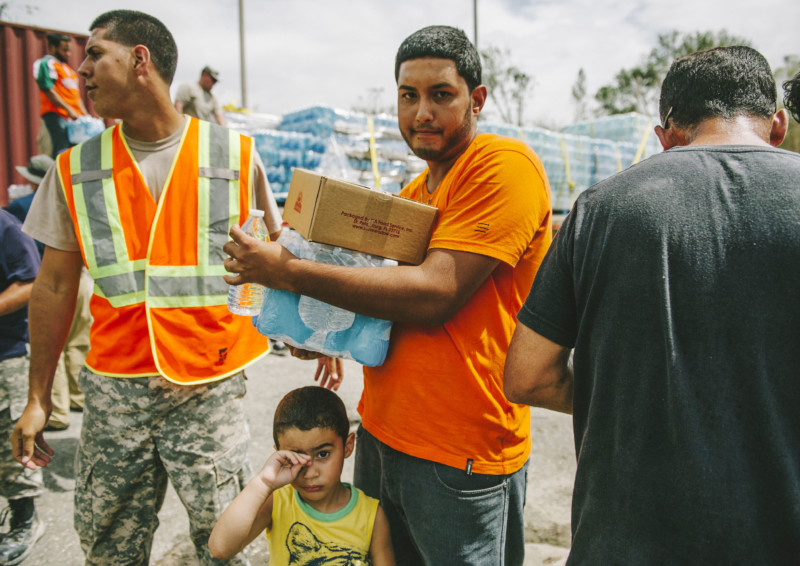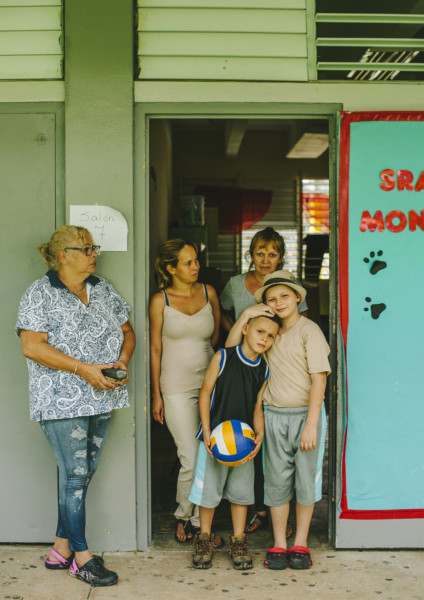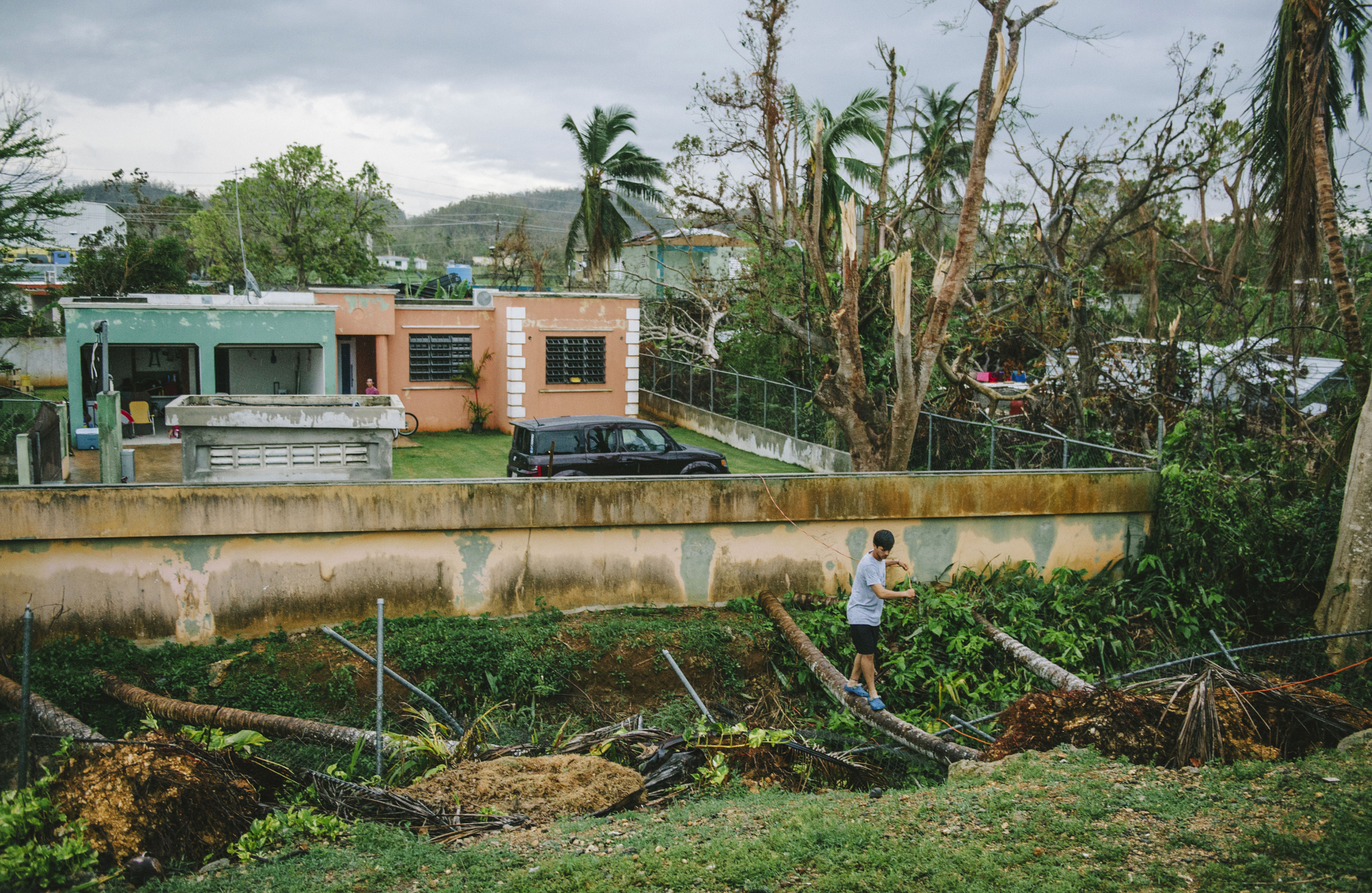Sign up for The Media Today, CJR’s daily newsletter.
Mainland American news outlets largely faltered in early coverage of Hurricane Maria in Puerto Rico. But when the press pilgrimage to San Juan finally happened, it included a two-man team from a small, niche education news outlet tucked into a corner of the Beltway.
Education Week, a national newspaper published 37 times per year, offers comprehensive coverage of the education policy world. It has previously reported on how catastrophic weather has lasting impacts on schools, most notably in New Orleans in the aftermath of Hurricane Katrina. The pages of Education Week are frequently filled with everything from policy dispatches from statehouses and Washington D.C. to deeply reported narrative stories that illustrate the consequences of the decisions made within them. But like most other outlets, the newspaper had run few, if any stories about the ailing Puerto Rican public school system before Maria. Education Week Editor Lesli Maxwell has been at the paper for 10 years and could recall just one story about Puerto Rican schools in recent memory. “We certainly had no Puerto Rico beat,” she says.
So when editors at the small outlet decided to send reporters to the island, it was a significant investment for a newspaper staffed by just 40 people, including editors, reporters, and the art department. Education Week’s expertise in federal policy positions it as one of the best outlets to help usher readers through the complicated relationship Puerto Rican schools have with the federal government, all while humanizing the dense policy changes that will inevitably come as the school system reinvents itself. If there is any outlet with the bandwidth to drudge through the years-long process of school reform, it’s Education Week.
ICYMI: President Trump’s “bizarre” tweet on Puerto Rico
When Harvey and Irma hit, stories about schools acting as crucial shelters and supply distribution centers for displaced people trickled in. But Maxwell says the press was slow to pick up the education angle in Puerto Rico.
“In the early days it was about survival and rescue, but we expected to start to see something,” says Maxwell. “We weren’t seeing much in the way of wire photos, but in Harvey and Irma, schools were a central part of sheltering people. We decided if we’re going to get this story, we have to get down there.”
Andrew Ujifusa, a veteran K-12 education reporter, had no special knowledge of the ailing Puerto Rican public school system. He spoke no Spanish and, in any case, most communications on the island had been down for weeks. So he relied on computer-based reporting (including a recent report submitted to Congress on the state of Puerto Rican schools) to bring himself up to speed ahead of a reporting trip. What he found was a relative dearth of public information compared to other large American school districts.
“Finding out information is tough. The National Center for Education Statistics last published the graduation rates of Puerto Rican students [in] 2012. Now imagine if we hadn’t published the graduation rates of California or for New Jersey or nationwide for five years. It would be like, ‘What are you doing? Where is that number?’” Ujifusa says. “But for Puerto Rico, it’s like, well …” His voice trailed off. The Puerto Rican school system serves roughly 350,000 students—a huge unified school system deserving of the same attention districts like Chicago get, says Ujifusa. Over the summer, the system suffered from numerous (sometimes controversial) school closures and a pension crisis.
As news outlets began to step up their coverage of Maria’s aftermath, some ran stories about school officials in places like Florida and New York as they were preparing for a potential influx of Puerto Rican students fleeing the island. Education Week ran such stories, too. But Ujifusa knew that there was more than just a hyperlocal story to be told. So he booked a flight.

Jeremy Vasquez collects water at a relief station set up at the Ramon Luis Cabanas baseball stadium in the San Jose neighborhood of Utuado, Puerto Rico.(Swikar Patel/Education Week)
With help from colleagues, Ujifusa was able to make contact with several sources living and working in Puerto Rico before he arrived, communicating with them primarily through text messages. “Without texts, we would have had a lot more trouble. Some of those [messages] didn’t go through. They would sit on my phone for hours and you’d get the spinning wheel of death,” says Ujifusa, who traveled with Education Week staff photographer Swikar Patel.
Ujifusa set up interviews with teachers, students, and the island’s secretary of education. His goal was to visit as many parts of the island as was feasible, writing short “vignettes” that would help document the fast-changing recovery effort. Patel, who had spent time in Puerto Rico before (Ujifusa covered the Haitian earthquake relief efforts), consulted with friends in the industry who had already visited the island, for tips on what gear and supplies to bring.
“The night before I left, Victor Blue [said to] bring clean water, dry food, canned food. To expect to not depend on eating,” says Patel. He traveled light, carrying with him a Canon EOS C100 camera, a tripod, a monopod, and two pouches he kept extra lenses, wireless microphones and extra batteries in.
The pair arrived on October 6 and realized quickly how crucial it would be for them to leave the city center. Patel filmed the approaching skyline as their plane descended for landing, and was struck by how normal it looked from the air. Their hotel had a generator. Chilli’s was open for dinner. Apart from a few closed exits and trees littering the road, Patel says some parts of San Juan looked no different than any number of Midwestern cities after a bad storm. The scope of the devastation became most clear when they got out of the city, where the damage was most acute.
They found schools without electricity and water, and full of debris. They met one teacher, who doubled as a fixer and translator, on the side of a highway outside her town. They rushed to finish their reporting before nightfall when, without electricity, most of the island outside San Juan was plunged into opaque darkness. In Arecibo, a coastal city 50 miles from San Juan, they met a former teacher of the year who, along with much of the high school’s staff, showed up daily to clear rubble and clean classrooms. A prominent chef organized cafeteria workers to turn their schools into food distribution centers, while a school director in Utuado oversaw the preparation of 500 meals. Seventeen bridges had been swept away, Ujifusa says. At another school doubling as a shelter, two brothers practiced their vowels and counting to 10 in English. A school in Bayamon hosted a read-aloud to boost morale–the elementary kids heard a story about a group of animals who survive a storm.
Our job as journalists is to shine a light on where the stories are, where the problems are, and that can be helpful to keep that issue visible.
The experience was a lesson in the ways covering the devastation of an institution interacts with human grief. And it was a reminder of how the reporting process can often exacerbate that pain, even as it does the important work of communicating it to outsiders.
“We talked to a teacher, but she had lost her house and her two daughters were living with her parents. She was asked ‘Why are you back at work?’ and she cracked,” says Ujifusa. “She couldn’t handle the question, it was too difficult thinking about it. Her life had been completely upended.”
Ujifusa and Patel spent one week in Puerto Rico, filing short dispatches, video interviews, and photos. They planned most of their days on the fly, rearranging interviews when they couldn’t reach sources and connecting with Spanish-speaking fixers who brought them to communities far from the city center. They met families, teachers, principals and caught up with the secretary of education, Julia Kelleher, to talk about recovery efforts and what the wreckage might mean for a future of innovation in Puerto Rican schools. In the evenings, they returned to their hotel to write and process images for editors back in Maryland. Late last month, Education Week published Ujifusa’s longer recount of the recovery efforts.
For Patel, making the decision to go to Puerto Rico wasn’t easy. Each time tragedy strikes, the media ties itself in knots over the ethics of swarming a place in crisis for quotes and soundbites juxtaposed with the reality of our responsibility to report the news. Ideas about how to fulfill that responsibility more sensitively continue to be tossed around.
ICYMI: NYTimes reporter’s thought about media coverage of mass shootings goes viral
“One of the things to get right was, ‘Why am I going to go?’,” says Patel. “I’m going to be another body taking water, taking food, taking, taking, taking.” He resolved to make the best use of his time, reaching out to fellow photographers who had been in Puerto Rico for help understanding what he could expect when he got off the plane. He relied on a friend who was a photographer and had relatives in Puerto Rico for cultural context. The idea was to avoid creating the same impersonal images of devastation—roads washed out, traffic lights dangling—that could be easily licensed if need be. Instead, he hoped to treat Maria as a backdrop for larger stories about schools and, ultimately, people.
“The disaster is the background. What we’re here for is schools. It’s easy to show people at their worst, but to show the resilience and the people doing the work and show them in an empowered light was super important for me coming into an area that is not mine,” says Patel.
Much of the images he produced were portraits, as well as several videos featuring interviews with subjects featured in Ujifusa’s reporting. They offer a crucial visual aide to readers miles away. Patel also shot a six-minute documentary released alongside a long recap piece Ujifusa wrote upon their return to Maryland.
Education Week’s dedication to on the ground coverage in Puerto Rico is significant—the small, nonprofit newsroom lacks the sort of financial resources larger publications and networks who more readily send journalists overseas have. And yet Patel, Ujifusa, and Maxwell all agree they have to go back.
“I doubt over the long term that the recovery and standing back up of Puerto Rican schools will get the kind of attention that New Orleans got and, frankly, continues to get. Our full intention is to send [Ujifusa and Patel] back,” says Maxwell. “We have not covered Puerto Rico in the way we cover the 50 states, but we’re talking about 350,000 students—that’s the equivalent of the fourth largest school system in the United States so we think it’s going to be a critical story for us.”

Gloria E. Colon, and from left, Glenda Ruiz, her mother, Rosa Rodriguez, and Ruiz’s two sons, Josh Rivera, 6, and Abdiel Rivera, 8, are using a classroom at Judith Avivas Elementary School in Utuado as their temporary home after Hurricane Maria destroyed their house. —Swikar Patel/Education Week
In New Orleans, Hurricane Katrina, of course, became a linchpin for one of the most radical and controversial school policy shifts in the country, and with help from regular, comprehensive media coverage, the city became a hotbed for education reform. But there has been, so far, no such interest in Puerto Rico.
“Our job as journalists is to shine a light on where the stories are, where the problems are, and that can be helpful to keep that issue visible,” says Maxwell. “It might inspire some people to come down and help if they’re reading Ed Week coverage about the enormous challenges schools in Puerto Rico are facing.”
Maxwell believes that the flood of outside resources from the education community will be much harder to attract to Puerto Rico, positioning the system’s recovery as “a lot harder to do than what we saw in New Orleans.”
Ujifusa’s conversations with education officials echo that thought. Paul Pastorek, a former superintendent of education in Louisiana, told him that he thinks Puerto Rico faces a recovery even more harrowing than that of schools post-Katrina, in part because of a lack of interest and knowledge in their particular struggles. And the toll on the mental health of students and teachers who stay could have, as we saw in Louisiana, lasting ramifications for the educational future of Puerto Rico’s youth.
“You have to step back and think about that. If that’s right, then these schools deserve ongoing coverage,” says Ujifusa.
ICYMI: A feud between two media giants
Has America ever needed a media defender more than now? Help us by joining CJR today.



